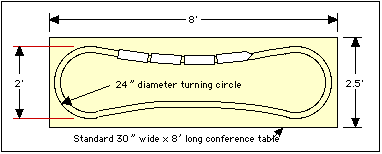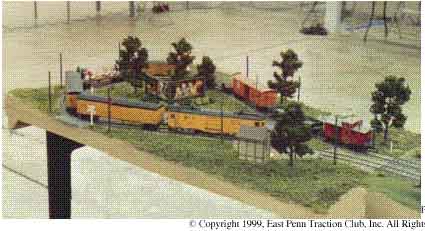<--Back to SSG Home Page
-
To:
|
- Mr. Don
Thompson
- S Helper
Service
- 2 Roberts
Road
- New Brunswick, NJ
08901-1621
|
Subject: S Gauge Rolling Stock
For Small Diameter Curves
Suggestion:
|
- Consider (someday)
maybe marketing a small S gauge hi-rail
engine (and possibly cars) that can operate
on small diameter track curves
(about
24" diameter)
|
|
Action
Requested:
|
Please file this in your
'Suggestions' folder.
|
This is one of those suggestions
that you might disagree with. Even if you don't disagree,
this may not be economically feasible. But this track
diameter topic is something that I am enough agitated
about, that I am writing you this note.
1. The
"Problem"
In my opinion, one of the
"weak spots" of S gauge is availability of good
running rolling stock, that can operate on small
diameter curves. With currently available S-Trax, the
smallest circle you can make is about 38"
diameter.
In other words, S gauge seems
to require a relatively large turning circle, compared
with some of the other scales.
For example, you can operate a
larger O gauge train on a 30" diameter curve that is
about 8 inches smaller. You can operate a much larger
G scale train on a 48" diameter curve that is only
about 10" larger.
2. Why Would Anyone In Their
Right Mind Want To Operate On A 24" Diameter Loop
?
Two possible
reasons:
- Displays at train
shows, to fit the standard 30" wide
table
- Home layouts in small
areas
3. Displays At Train
Shows
One of my interests is in
constructing small displays for train shows. It seems
like it would be handy to be able to have equipment
that would operate on a track of about 24" diameter.
Then you could construct a layout that would fit on
the standard 30" wide conference table that they
usually use at train shows.
Figure 1 below shows how a
simple oval could fit on the standard 30" wide
table.

Figure 1 -- Display Layout On A 30" Wide Table
Figure 2 below shows how
the ends of the layout could be covered with scenery,
so the minimum VISIBLE radius would be fairly
large.

Figure 2 -- Same Layout, But With Scenery Hiding Sharp
Curves
4. Home Layouts In Small
Areas
Some people may be
"forced down" to HO or N scale or point to point
layouts, because they don't have enough space for the
"standard" 38 inch diameter turning circle required
for S gauge.
If they could turn in a 24"
diameter, this might give them a chance to use S gauge
in smaller areas, where the standard 38" diameter will
not fit.
5. What Size Would An S Gauge
Track Circle Be, If It Was Proportional To G or O Scale
?
G SCALE -- If you examine
LGB's G-scale trains, scale 1:22.5, their starter
engines, their larger engines like the 2-6-0 Mogul,
and their large ALCO diesel; can all negotiate a 48"
diameter circle.
If you proportion this diameter
to S gauge, an equivalent S gauge diameter would be
about 17"
diameter [
(22.5/64) x 48" dia. = 16.87 inches dia.
].
O GAUGE -- If you examine
Weaver O gauge in hi-rail, a scale length E9 diesel
pulling proper length passenger cars seems to be able
to go around a 30" diameter circle. If you proportion
this diameter to S gauge, an equivalent S gauge
diameter would be about 23" [ (48/64) x
30" dia. = 22.5 inches dia. ].
Generally these
diesels use power trucks where the motor and drive
is all part of the truck, so there are no u-joints
that have to bend on the corners. Bachman also does
this in HO scale with their GE 44 tonner diesel;
each truck has its own motor and gearbox all
integral with the truck.
The following Figure 3 shows an
O gauge trolley train turning on what I think is a 24"
wide module. These traction guys seem to be the
experts at getting trains around sharp
corners.

Figure 3 -- Sharp Radius Turnaround Loop On A 24" Wide O
Gauge Module
6. What Do I Have In Mind For
S Gauge
The easiest way to do
this would be maybe a small 0-4-0 diesel. If you look
at G scale, Aristo Craft made their Little Critter by
apparently using the cab portion of their RS3 diesel.
Something similar in appearance to this engine could
probably be built in S gauge.
If you look at LGB, their
little 0-4-0 Stainz steam engine is the "cornerstone"
of all their starter sets. An S gauge version of that
engine (Americanized) would probably look good and be
able to negotiate sharp curves.
COUPLERS -- Possibly some sort
of special coupler would be needed. A simple link and
pin would probably do the job. The one-piece link
could be disguised to look like a pair of knuckle
couplers for realistic appearance. (I have observed
the battery-powered trains they use inside malls to
provide rides for little kids. The trains go around
incredibly tight curves, about 8 foot diamter, for a
train that has about a 2 foot track gauge. And I
notice that they use link and pin.)
7. Other
Comments
I was fooling around the
other night, with some old American Flyer Pikemaster
30" diameter track. My S Helper SW-9 appeared to be
able to negotiate the Pikemaster curves. But I don't
think the SW-9 would be very "happy" doing it all day
long on a display layout.
Besides that, the Pikemaster
track seems poor with respect to electrical
connectivity. I had lots of problems just keeping
electrical continuity from one section to
another.
As I was struggling with this
Pikemaster track, I was thinking to myself,
"I would
sure like to have a loop of my great-running,
easy-to-set-up SHS S-Trax, but about 24" diameter;
plus a small SHS engine and cars with appropriate
couplers, that were designed to negotiate these
curves".
8. Why Am I Writing This
Letter To Don Thompson ?
Running an S gauge train
around a small radius turn is something I plan to work
on in the future, if my interest in this subject
continues, and I don't die of old age first. However,
since you seem to get things accomplished about 100
times faster than I seem to, I thought I should try to
arouse your interest in this small radius
subject.
Mass producing track for this
small diameter may not be possible. But do you think
it might be practical to mass produce a small engine,
that would just happen to have the capability of
negotiating sharp curves ??
9. Other
Possiblilities
In my 1996 Scenery
Unlimited catalog, I see they have Rex 0-4-0 docksider
engines advertised, in scale versions only. If these
0-4-0's are still around, one could probably hand-lay
a 24" diameter track, and use one of these
engines.
But I really prefer to use
hi-rail. (I can hardly see the difference between the
hi-rail flanges on my SHS SW9, and scale flanges.
Staying hi-rail allows me to operate with the Flyer
guys. And hand-laying track is way over my current
skill level, plus cumbersome to put up and take down.
I've looked at the American Models and Gargraves flex
track, but I can't see how it could be bent to a sharp
radius without destroying it. )
If you have any ideas for
getting a train around a sharp curve like I am talking
about, that I apparently have not thought of, please
let me know if you get a chance (my email is at the
top).
Thanks for
listening.
Jim Ingram
|


